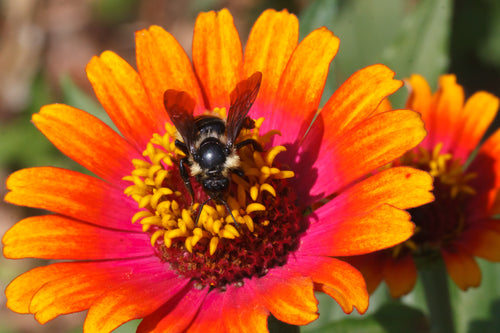

Introducing the PollinateHV Collection,
A Collaboration with Partners for Climate Action
Here at the Hudson Valley Seed Company, we are plant lovers. We also greatly admire the creatures that pollinate them and hope you do, too.We are excited to announce our partnership with PollinateHV, a project of Partners for Climate Action, that aims to inspire gardeners to protect the Hudson Valley’s threatened native pollinators.
PollinateHV’s Pollinator Action Guide is an online resource designed to support people through the process of creating habitat for our native pollinators, especially those at risk of extinction. We at Hudson Valley Seed Company have been collaborating with PollinateHV since 2022 to produce local ecotype native seeds for a variety of pollinator-supporting plant species.
The PollinateHV collection features 20 plant species selected from the PollinateHV plant list, and the first varieties will be released this summer. As our plantings mature, seeds of additional species will become available over the next year.
What is a Local Ecotype?
Local ecotypes are plants that have a genetic heritage unique to a particular place. Growing local ecotype plants starts with the local collection of wild seeds.
We worked with professional seed collectors to source “parent seed” from wild populations across the Hudson Valley. Now, plants grown from those parent seeds are thriving at our very own Four Fold Farm, producing farmed seed for harvest and sale. Since these native plants are perennials, we can expect a bountiful seed harvest for years to come!
Using local ecotype plants and seeds helps protect the biodiversity of native species by preserving genetic diversity. It’s also the best way to support local pollinators, birds, and wildlife, whose needs are closely adapted to the life cycles of local plants and the unique climate and soil conditions of their native region.

Purplestem Aster
What are Pollinators and What Do They Do?
Bees, butterflies, moths, beetles, flies, bats, and birds work hard to pollinate the flora of our region and are essential to the health of our natural ecosystem. They transport pollen from the male parts (stamen) of flowers to the female parts (stigma), allowing plants to reproduce and create seeds. Over 80% of all flowering plants worldwide reproduce with the help of animal and insect pollinators. This includes not only flowers, but fruit and vegetable plants as well. We need

Bombus Borealis (Northern Amber Bumblebee)
Which Pollinators are at Risk?
Globally, 40% of insects are believed to be at risk of extinction, and a recent report found that up to 60% of New York State pollinator species may be facing extinction as well. Threats to pollinators’ survival include ongoing habitat loss, pesticide use, invasive species, diseases, and climate change. Despite nature’s resilience, these combined threats can build on one another and wreak havoc on our ecosystems.
We’ll introduce some of our threatened pollinator species and the plants that support them in an upcoming blog post.
What Does it Matter if a Few Pollinators go Extinct?
The resilience of our ecological communities, especially in the face of climate change, depends on their biodiversity. Research shows that the more diverse an ecological community is, the better it can respond to stressful disturbances since there are enough species to perform all essential roles.
Globally and locally, pollinator and plant diversity is declining. Scientists estimate that if current trends continue, most insects will vanish by the end of this century, with impacts reverberating across food webs and human systems like agriculture.
How Can I Help?
There are many things you can do to help and the time is now. If you have access to land (even a backyard or container garden) consider planting local ecotype native plants that support the diverse population of pollinators. Check out the Pollinator Action Guide for details on finding pollinator plants for your site conditions, best practices for planting and management, and much more. The Action Guide also includes in-depth information about the Hudson Valley’s native plants and pollinators.
Your actions affect the environment, but your impact can be a positive one. Try to support companies that are helping, not hurting, the planet. Remember that eating is a political act. Support local organic farms or grow your own food. Avoid pesticides and spread the word about these issues to friends, family, and neighbors.
Together we can support pollinators and maintain the beautiful ecological diversity of the Hudson Valley.

Example of the helpful guides you'll find on Pollinate HV's website.

